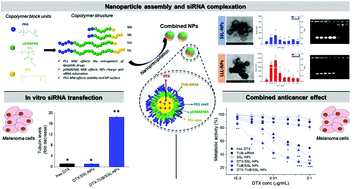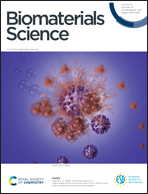PEGylated cationic nanoassemblies based on triblock copolymers to combine siRNA therapeutics with anticancer drugs†
Abstract
Nowadays, the clinical administration of siRNA therapeutics is still challenging due to the need of safe and efficient delivery carriers. In this context, biodegradable and amphiphilic triblock copolymers (ABC) containing amine–based cationic segments could be a powerful tool for siRNA delivery. Herein, we propose a range of poly(ethylene glycol) (PEG)–poly(2-dimethyl(aminoethyl) methacrylate) (pDMAEMA)–polycaprolactone (PCL) copolymers with different lengths of the blocks and hydrophilic/lipophilic balance to deliver siRNA alone or in association with a conventional anticancer drug. mPEG–pDMAEMA–PCL copolymers were synthesized by a combination of techniques and characterized by NMR analysis, Fourier transform infrared (FTIR) spectroscopy, gel permeation chromatography (GPC) and differential scanning calorimetry (DSC). Copolymers were then employed to prepare NPs through nanoprecipitation. NPs based on copolymers with long PCL chains (SSL-NPs and LLL-NPs) showed the best colloidal properties and a highly stable core–shell structure with a better orientation of the PEG fringe on the surface. Concerning siRNA delivery, SSL-NPs based on copolymers with short PEG and pDMAEMA chains showed optimized ability to complex and then deliver siRNA at the cell level. The strong interaction between the nucleic acid and the cationic pDMAEMA blocks of NPs was then confirmed by release studies that showed a sustained release of siRNA within 48 h. The transfection efficiency of NPs was assessed in human melanoma cells. NPs were complexed with a therapeutic siRNA against TUBB3 (TUB-siRNA). We observed the best results with SSL-NPs, probably due to the higher preserved buffer capacity of the pDMAEMA blocks. Finally, in order to give a proof of concept of a possible application in the combined chemo/gene-therapy of cancer, SSL-NPs complexed with TUB-siRNA were loaded with docetaxel (DTX) and then cytotoxicity was evaluated in the same cell line. The co-delivery of TUB-siRNA into NPs appeared to strongly potentiate the anti-proliferative activity of DTX, thus highlighting the combinatory activity of the NPs.



 Please wait while we load your content...
Please wait while we load your content...